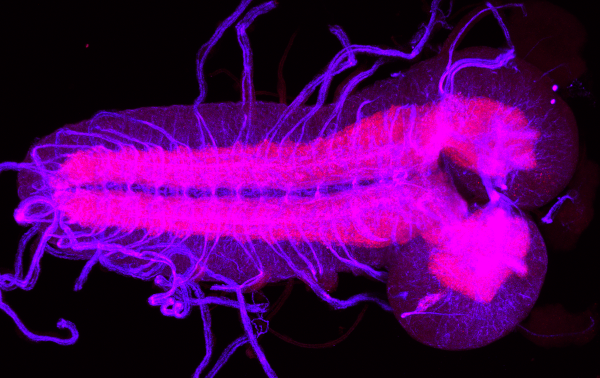
Neuroanatomy of the Drosophila Larva
Motivation
With its only about 10.000 neurons, the central nervous system of the Drosophila larva is sufficiently small to enable a complete anatomical reconstruction with all neurons and their connectivity. At the same time, the larva and its behaviour are complex enough to be of interest for neuroethology, and Drosophila is arguably the most important model organism in contemporary biology.
Scientific Questions
In this project, we develop methods that support neurobiological research on the larval Drosophila brain, for the analysis of light microscopical and electron microscopical data, as well as for reconstructed 3D neuron structures, so-called “neuron skeletons”.
In particular, we have constructed a standard brain (central nervous system) from light-microscopical image stacks of the Drosophila larva. With the help of our software larvalign, users can now register their own image stacks into the reference coordinate system defined by the standard brain (Muenzing et al., 2018). A follow-up project focusses on multimodal registrations between light microscopical and electron microscopical scans.
We have also developed computational tools for data analysis and visualization of neuroanatomical data, such as anatomical reconstructions of individual neurons: Simplified, but topologicaly correct, dendrogram sketches of 3D neuron skeletons allow visualizing morphologically complex neurons and their connectivity in local neural circuits (Strauch et al, 2018, Schleyer et al., 2020).
Partners
- Prof. Dr. Andreas Stephan Thum, Institute für Biology, University of Leipzig
- Dr. Katja Bühler, VRVis Zentrum für Virtual Reality und Visualisierung Forschungs-GmbH, Vienna
- Prof. Dr. Volker Hartenstein, Department of Molecular, Cell and Developmental Biology, University of California, Los Angeles
External Funding
- DFG Research Grant, “The larval 4D standard brain of Drosophila melanogaster on a single cell level”, Project nr. 266382180
- DFG Research Grant, “Larvalbrain 2.0: A research platform for the larval brain of Drosophila melanogaster”, Project nr. 441181781
Contact
Publications

Identification of dopaminergic neurons that can both establish associative memory and acutely terminate its behavioral expression
In: Journal of Neuroscience 40 (31)





